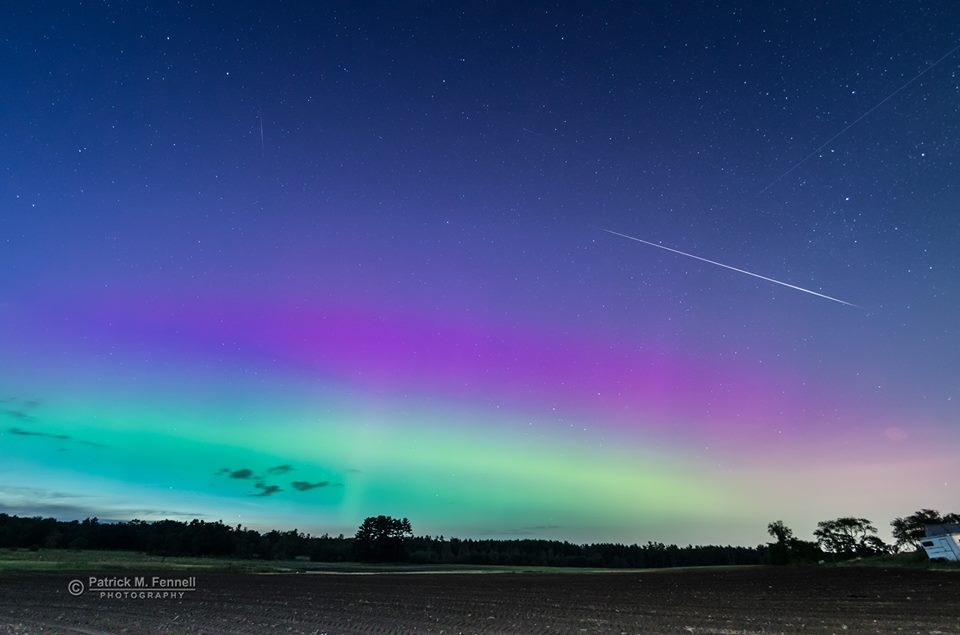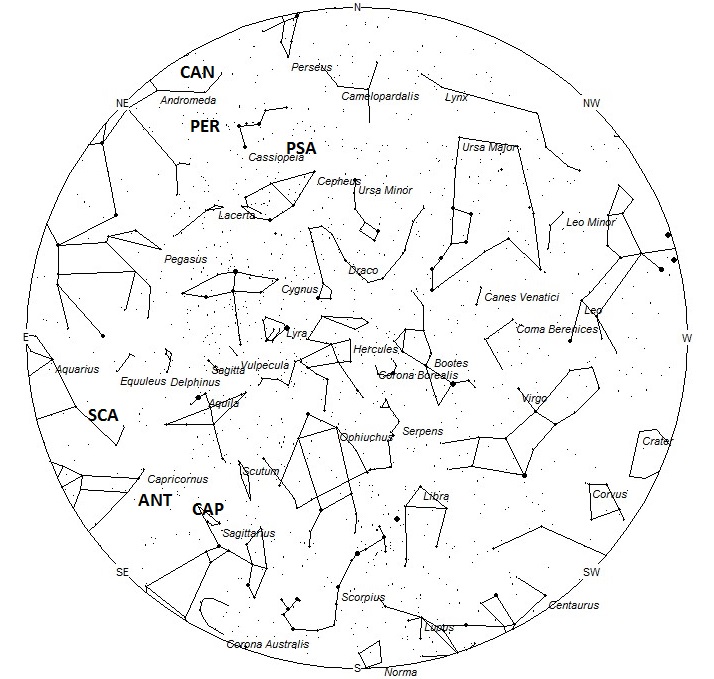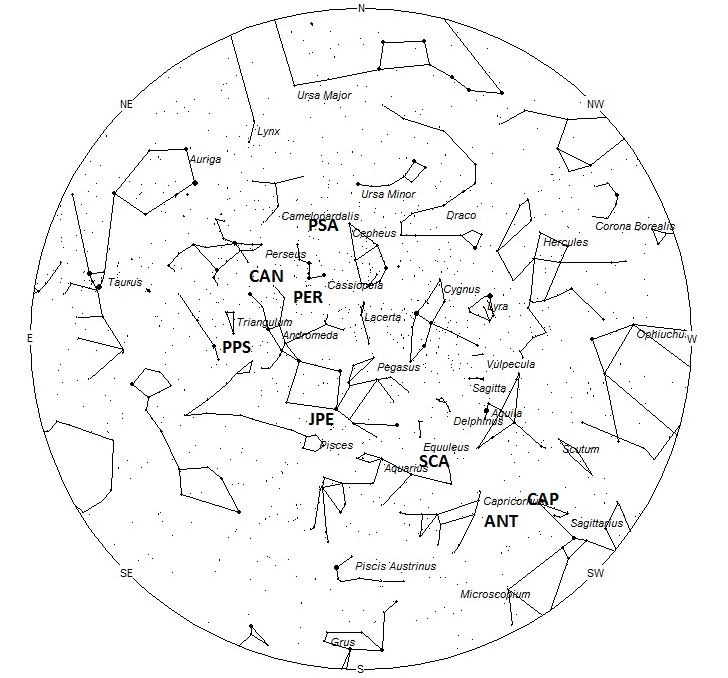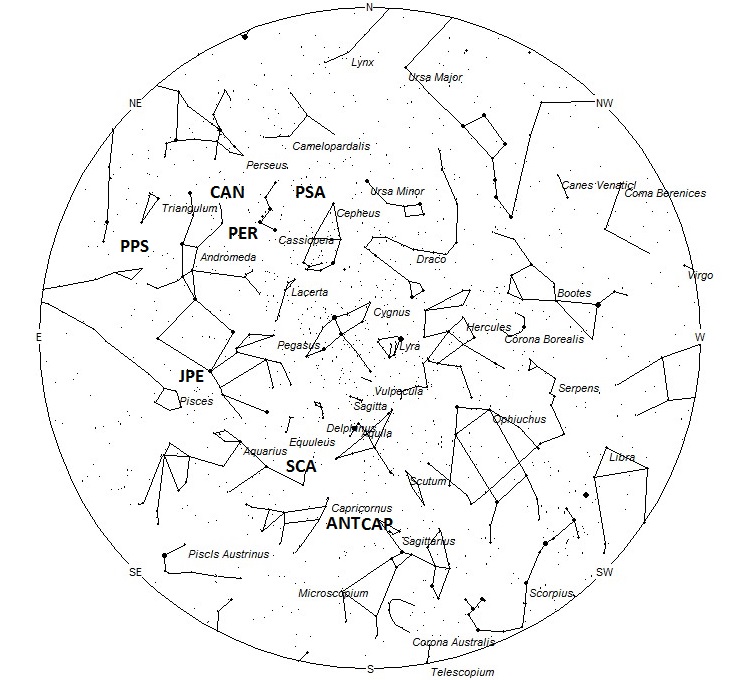
© Aurora and Meteor – June 22, 2015 – 9:56PM Saco, Maine USA Patrick Fennell – Follow Patrick on Facebook

Radiant Positions at 10pm Local Daylight Time

Radiant Positions at 4am Local Daylight Time

Radiant Positions at 1am Local Daylight Time
During this period the moon reaches its new phase on Thursday July 16th. At this time the moon is located near the sun and is invisible at night. This weekend the waning crescent moon will rise during the late morning hours and will not interfere with meteor observing as long as you do not include it within your field of view. The estimated total hourly meteor rates for evening observers this week is near 4 for observers situated at mid-northern latitudes and 5 for observers viewing from the southern tropics (latitude 25 S.). For morning observers the estimated total hourly rates should be near 16 no matter your location. Evening rates are reduced this week due to moonlight. The actual rates will also depend on factors such as personal light and motion perception, local weather conditions, alertness and experience in watching meteor activity. Note that the hourly rates listed below are estimates as viewed from dark sky sites away from urban light sources. Observers viewing from urban areas will see less activity as only the brightest meteors will be visible from such locations.
The radiant (the area of the sky where meteors appear to shoot from) positions and rates listed below are exact for Saturday night/Sunday morning July 11/12 These positions do not change greatly day to day so the listed coordinates may be used during this entire period. Most star atlases (available at science stores and planetariums) will provide maps with grid lines of the celestial coordinates so that you may find out exactly where these positions are located in the sky. A planisphere or computer planetarium program is also useful in showing the sky at any time of night on any date of the year. Activity from each radiant is best seen when it is positioned highest in the sky, either due north or south along the meridian, depending on your latitude. It must be remembered that meteor activity is rarely seen at the radiant position. Rather they shoot outwards from the radiant so it is best to center your field of view so that the radiant lies at the edge and not the center. Viewing there will allow you to easily trace the path of each meteor back to the radiant (if it is a shower member) or in another direction if it is a sporadic. Meteor activity is not seen from radiants that are located below the horizon. The positions below are listed in a west to east manner in order of right ascension (celestial longitude). The positions listed first are located further west therefore are accessible earlier in the night while those listed further down the list rise later in the night.
These sources of meteoric activity are expected to be active this week.
The Alpha Capricornids (CAP) are active for over a month lasting from July 6 through August 10. Unlike most showers, the Alpha Caps have a plateau-like maximum with maximum activity lasting from July 25-30. Since maximum activity is still 2 weeks away, hourly rates will be less than 1 no matter your location. The radiant is currently located at 19:22 (291) -15. This area of the sky is located in northeastern Sagittarius, 3 degrees north of the 4th magnitude star known as Rho 1 Sagittarii. The radiant is best placed near 0100 local daylight time (LDT) when it lies on the meridian and is highest in the sky. With an entry velocity of 22 km/sec., the average Alpha Capricornid meteor would be of slow velocity.
The center of the large Anthelion (ANT) radiant is currently located at 20:08 (302) -19. This position lies on the Sagittarius/Capricornus border, 5 degrees southwest of the 3rd magnitude star known as Dabih (Beta Capricorni). These meteors may be seen all night long but the radiant is best placed near 0200 LDT when it lies on the meridian and is positioned highest in the sky. Due to the large radiant area, meteors from this source may also appear to radiant from the constellation of Microscopium, Scutum, southern Aquila, western Aquarius, and western Capricornus as well as Sagittarius. Rates at this time should be near 1 per hour as seen from the northern hemisphere and 2 per hour as seen from south of the equator. With an entry velocity of 30 km/sec., the average Anthelion meteor would be of slow velocity.
The Sigma Capricornids (SCA) were discovered by Zdenek Sekanina and are active for a month lasting from June 19 through July 24. Maximum occurred on June 27th. The radiant is currently located at 21:12 (318) -04. This area of the sky is located in northwestern Aquarius, 5 degrees northwest of the 3rd magnitude star known as Sadalsuud (Beta Aquarii). The radiant is best placed near 0300 LDT when it lies on the meridian and is highest in the sky. Rates at this time should be near 1 per hour no matter your location. With an entry velocity of 42 km/sec., the average Sigma Capricornid meteor would be of medium velocity.
The July Pegasids (JPE) are active from a radiant located at 23:20 (350) +11. This area of the sky is located in southwestern Pegasus, 5 degrees southeast of the 2nd magnitude star known as Markab (Alpha Pegasi). This area of the sky is best seen during the last dark hour before dawn when the radiant lies highest in a dark sky. Maximum activity occurred on July 10th so rates this weekend are expected to be near 1 per hour no matter your location. With an entry velocity of 68 km/sec., the average meteor from this source would be of swift velocity.
The first members of the famous Perseid (PER) meteor shower should begin to appear this week. Don’t expect these early Perseids to appear from Perseus as the actual radiant lies at 00:08 (002) +49. This area of the sky lies in southern Cassiopeia, 8 degrees southwest of the 2nd magnitude star known as Schedar (Alpha Cassiopeiae). This position is 45 degrees west of the position of the Perseid radiant on the night of maximum activity (August 13th). Since the maximum is still a month away, rates are expected to be low, probably around 1 per hour during the late morning hours. Observers south of the equator will have difficulty seeing any activity as the radiant lies low in the north at best. With an entry velocity of 61 km/sec., the average Peresid meteor would be of swift speed.
The Phi Piscids (PPS) were discovered by Dr. Peter Brown in his meteoroid stream survey using the Canadian Meteor Orbit Radar. This shower was later verified by Dr. Peter Jenniskens and David Holman using data from the CAMS network in northern California. These meteors are active from June 11 through July 25 with maximum activity occurring on July 2nd. The current position of the radiant is 01:32 (023) +30. This position lies in northeastern Pisces, 7 degrees west of the 3rd magnitude star known as Ras al Muthallah (Alpha Trianguli). Rates are currently expected to be near 2 per hour no matter your location. With an entry velocity of 68 km/sec., the average Pi Piscid meteor would be of swift speed.
The Psi Cassiopeiids (PSA) were discovered by Zdenek Sekanina and are active from July 12-18, with maximum activity occurring on the 16th. The radiant is currently located at 01:32 (023) +69. This position lies in north-central Cassiopeia, 9 degrees north of the 3rd magnitude star known as Ksora (Delta Cassiopeiae) . Rates at maximum are expected to be near 1 per hour as seen from the northern hemisphere. These meteors are not well seen from south for the equator. With an entry velocity of 46 km/sec., the average Psi Cassiopeiid meteor would be of medium speed.
The c-Andromedids (CAN) were discovered by Sirko Molau and Juergen Rendtel using data provided by the IMO video network. These meteors are active from June 26-July 20 with maximum activity occurring on the July 12th. The current position of the radiant is 02:10 (010) +48. This position lies on the Andromeda/Cassiopeia border, 6 degrees north of the famous 2nd magnitude double star known as Almach (Gamma Andromedae). Rates, as seen from the northern hemisphere, are expected to be near 1 per hour. Rates seen south of the equator would be less than 1 per hour. With an entry velocity of 60 km/sec., the average c-Andromedid meteor would be of swift speed.
As seen from the mid-northern hemisphere (45N) one would expect to see approximately 8 sporadic meteors per hour during the last hour before dawn as seen from rural observing sites. Evening rates would be near 3 per hour. As seen from the tropical southern latitudes (25S), morning rates would be near 10 per hour as seen from rural observing sites and 4 per hour during the evening hours. Locations between these two extremes would see activity between the listed figures.
The list below offers the information from above in a tabular form. Rates and positions are exact for Saturday night/Sunday morning unless specified.
| SHOWER | DATE OF MAXIMUM ACTIVITY | CELESTIAL POSITION | ENTRY VELOCITY | CULMINATION | HOURLY RATE | CLASS |
| RA (RA in Deg.) DEC | Km/Sec | Local Daylight Saving Time | North-South | |||
| Alpha Capricornids (CAP) | Jul 27 | 19:22 (291) -15 | 22 | 01:00 | <1 – <1 | II |
| Anthelions (ANT) | – | 20:08 (302) -19 | 30 | 02:00 | 1 – 2 | II |
| Sigma Capricornids (SCA) | Jun 27 | 21:12 (318) -04 | 42 | 03:00 | 1 – 1 | IV |
| July Pegasids (JPE) | Jul 10 | 23:20 (350) +11 | 68 | 05:00 | 1 – 1 | IV |
| Perseids (PER) | Aug 13 | 00:08 (002) +49 | 61 | 06:00 | 1 – <1 | I |
| Phi Piscids (PPS) | Jul 02 | 01:32 (023) +30 | 68 | 07:00 | 2 – 2 | IV |
| Psi Cassiopeiids (PSA) | Jul 16 | 01:32 (023) +69 | 46 | 07:00 | 1 – <1 | IV |
| c-Andromedids (CAN) | Jul 12 | 02:10 (010) +48 | 60 | 08:00 | 1 – <1 | IV |
 American Meteor Society
American Meteor Society
QUESTIONS
1. RELATIONSHIP BETWEEN FIRE BALLS AND CME’S
2. RELATIONSHIP BETWEEN FIRE BALLS AND SUNSPOTS
3. RELATIONSHIP BETWEEN CORONAL HOLE AND FIRE BALLS
4. THE STATS ON FIRE BALLS –ARE THEY INDEED INCREASING DRAMATICALLY
Sandy,
1. None
2. None
3. None
4. No
I hope this helps!
Robert Lunsford
American Meteor Society
I saw a massive fireball shooting across the sky last night in Round Rock. One of the most spectacular things I have ever seen. It startled me at first because it was so large and firey with a firey tail.